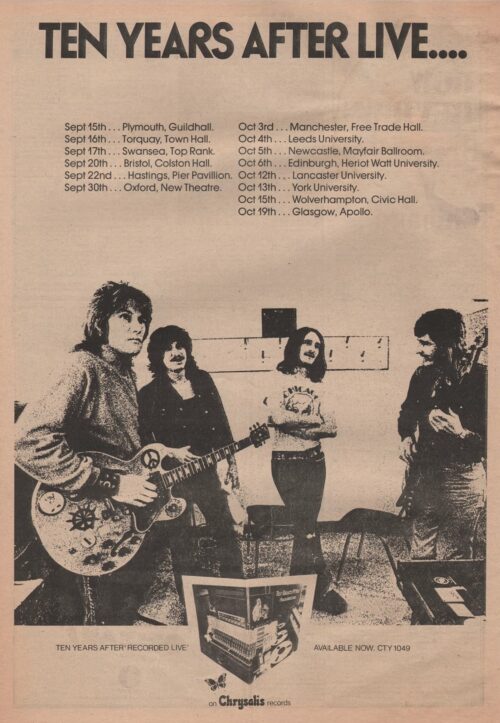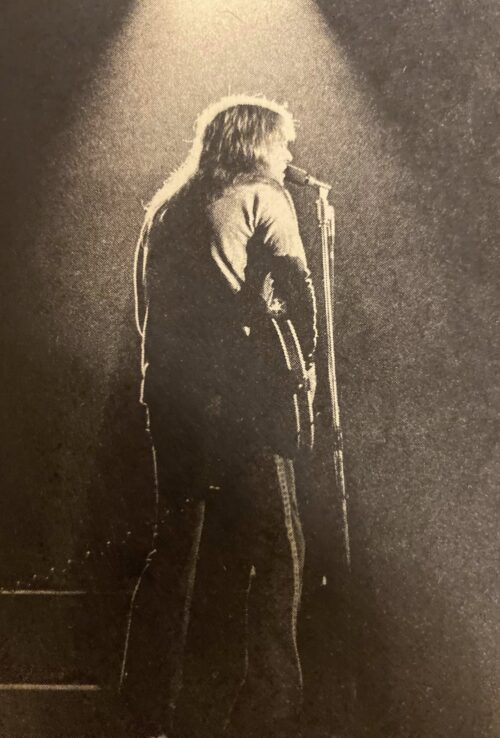
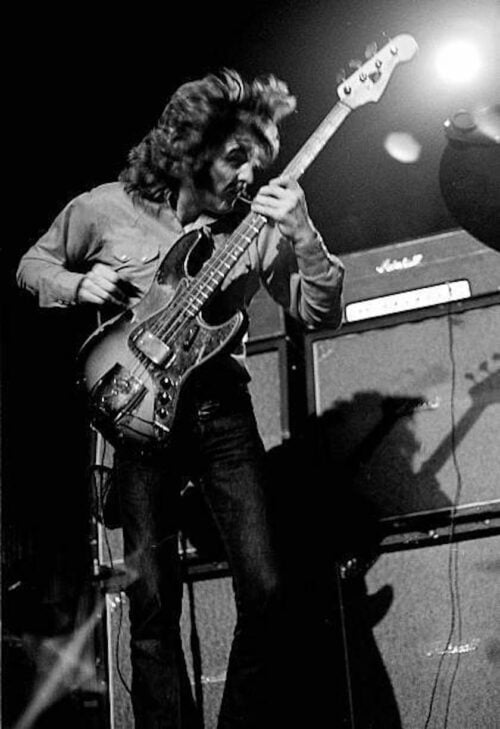
Music Trade News

Alvin Lee: Converted Barn
ALVIN’S STUDIO:
Alvin Lee – Lead guitarist with Ten Years After, has created a modern luxury recording studio out of an old barn in the grounds of his five hundred year old house in Oxfordshire.
Designed and built by musicians, rather than technicians, it took six months to complete and will be used exclusively by Alvin and his friends, starting with a big session for an LP now in progress, featuring Alvin Lee, Ian Wallace, Mel Collins, Boz Burrell and American musicians, Mylon LeFevre, Alan Toussaint and Felix Pappalardi.
Alvin’s assistant and studio engineer is Harold Burgon, an electronics freak, who also plays guitar and piano, has formed a production company called “Space Productions” to handle recordings made in the studio.
Equipment comprises Studer 16 and 2 track machines, M16 Dolbys, Helios eighteen channel desk, Tannoy and JBL monitors, Radford power amplifier, Neumann, AKG and Sure mikes, EMT echo plate, two Revox tape loops and a desk fitted with a special remote box, which can be operated by one person and has constant impedance direct injection input.
By Chris Hayes – 1973
New Musical Express — July 7, 1973

WHEN a musician refers to his band as a travelling jukebox, as Alvin is liable to describe Ten Years After these days, it’s a sure sign that the band is no longer the creative force it once was.
In the case of Ten Years After that’s exactly how Alvin Lee feels. It’s a problem that’s worried him for sometime now, and indirectly is one reason why he’s looking forward to opening his new studio that’s built into a barn standing on one of the forty acres of his enormous 15th century manor house that’s located near Reading.
This is to be the setting for some activities Lee has planned outside the auspices of Ten Years After and which he hopes will eventually benefit the band as a whole.
The house once owned by developer Charles Clore, is impressive even by the highest standards of the rock aristocracy. There’s wood panelling, a maze of rooms and that odd kind of eerie stillness that lends to hang in the air at some stately homes.
It’s especially apparent around the main hall and staircase, where you feel you ought to tread lightly and speak only in whispers.
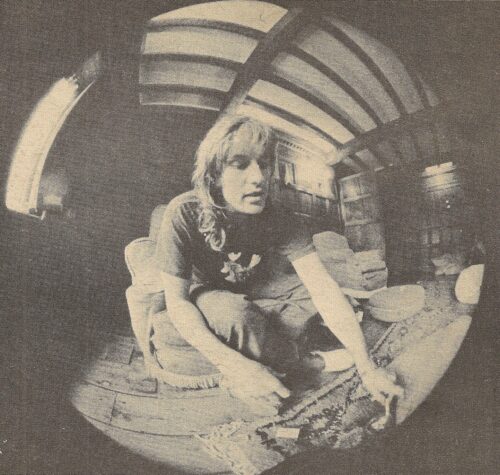
Things are different in the kitchen though, the gathering point for the twelve man crew that have been working on Lee’s new studio outside.
However, combining now with other musicians has already helped him considerably. “My own guitar playing has come along incredibly since I started playing with new people, also they’ve been turning me on to new musicians I’ve never even heard of before. It seems like a lot of doors have suddenly opened, I feel now I’ve given myself the opportunities and facilities to do anything possible.”
The beamed ceiling looks down on a plethora of activity while Lee himself moves around taking it all in somehow with the style of a pleasant but slightly pre-occupied lord of the manor. In one sense he worries about Ten Years After being groundless, since their popularity appears to be as strong as ever. They’ve just completed their 19th tour of the States, followed by a series of dates around Japan. There’s little to suggest that the band couldn’t carry on in a similar vein for several more years to come.
In fact it all seems so easy to keep Ten Years After rock and roll machine on the road, and the money pouring in, that they’ve already been accused of simply working out until their retirement.
It’s that kind of impression that Alvin Lee is trying to avoid.
At present he lives a luxurious life style, but by the time he’s finished the studio he confesses that he’ll be set well back financially. Also he rightly points out that Ten Years After have always been a hard working band, out on the road somewhere in the world for most of the last seven years. That perhaps, is part of the trouble now. That kind of continuous work can make a band stale, directionless – just a travelling juke box perhaps. Alvin Lee at least has seen the danger signs. As the rain poured down outside he explained with admirable honesty:
“Every band has their limitations and as we’ve been together so long we’ve tended to fall into old grooves and styles of playing rather than attempt anything new. For example I found my guitar playing was, if not exactly standing still, maybe going round in circles, along with my writing.
I think we’re still progressing, but the process has been getting slower and slower. I think it can happen to any band who stay together for so long. We were very experimental and now it’s just fallen into a format. It was bound to happen in a way, you can’t expect to blow your own mind every night….but if you don’t it gets to the point where playing is just really work. I mean, I don’t think any of us listen now to the type of music we play – which is really rather amazing. I can’t listen to a heavy record now without getting super critical about it.
Up till about a year ago I was intent on taking Ten Years After and my own style within the band as far as it would go. Then I reached a point where I seemed to come up against a brick wall and I decided that I needed a lot of other influences to help me through it.”
Since the whole band felt much the same way, the solution was to take five months off, experiment with new ideas on their own and then come back and work on the band’s music from there. Alvin Lee also emphasises that there’s no question of them splitting permanently.
“We all started to get a bit fed up with touring and working the whole while. It became a drudge and everybody sort of said they weren’t really happy doing it. After all, most musicians are the kind of people who want to be free, and touring the whole time is a long way from freedom. If we’d just carried on grinding ourselves into the ground, sooner or later one of the band would have said they’d found something else that they would rather be doing, so before somebody did say it, we decided to experiment instead.”
For Alvin Lee this now means an intense spell of activity centred around his studio which is due to be completed this week, and starting with an album he’s recording with Allen Toussaint, Felix Pappalardi and Mylon, who’s a throaty gospel singer from Macon, Georgia. “Then I’ll concentrate on my solo album and also I’ll be making an album with Boz, Ian Wallace, Mel Collins and Tim Hinkley. After that I want to bring the band into the studio and work on some new ideas from there.”
Alvin in fact already recorded some tracks last year with Mylon in Roger Daltrey’s studio and has been playing with Collins and Wallace. He admits it’s only recently that he’s wanted to work with other musicians, in the past always having avoided any of the sessions that were readily open to him. “I always cut myself off a bit, I’m not a great socialite.” He smiled, perhaps just a shade sceptically, “I don’t drink either, which seemed to put me out of most of the big London scenes.”
“Once we open the studio all there will be left to do, is just do it. I’ll be a great booster for me, a good kick in the pants ya know.” Lee’s first solo album will probably be completely recorded on his own in the studio. “I want to use the guitar as a basic and then use multi-tracks and tricks and harmonies on top of that. Possibly I might use somebody else, but mostly I plan to just sit in the studio and record it myself. Still it would be much looser than recording a normal album. Hopefully it’s going to be very different to anything I’ve done before, that’s what I’m aiming at…to break out of the conventional things I’ve been into – It’s much easier to do that on your own because you only have yourself to argue with.”
Despite this spate of work, Alvin Lee insist the future of Ten Years After is still healthy. Summing up, he said,
“I just want to see the band moving into another direction from travelling around the world, playing the same thing all the while. To be honest, we could easily have just carried on doing that. The concerts we play are all great and we got fantastic receptions everywhere, but what’s more important is what we feel inside ourselves and right now we feel we should be going somewhere else.”
But does he know exactly where?
“I was pretty mind blown when I heard the Mahavishnu Orchestra recently, and perhaps that’s how I’d like to see Ten Years After in a few years time…..but I don’t know really, we’ve got to find our own natural direction.”

From A German Album Cover
Recorded Live — Ten Years After
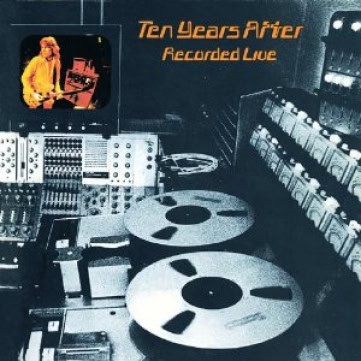
Album Note:
This album is a truthful recording of Ten Years After with no overdubs or additives. What you hear is what happened on the night. Recorded over four nights in Amsterdam, Rotterdam, Frankfurt and Paris with the Rolling Stones mobile recording truck and later mixed from sixteen track to stereo at Olympic Studios in London. In answer to the inferior live recordings sold illegally, this is the official Ten Years After bootleg.
Ten Years After: Live 2 LP Set
Nadat ik de besprekingen over de lp’s “Ten Years After Recorded Live” had gelezen heb ik de pen ter hand genomen. Ik ben niet zo weg van Ten Years After, omdat ik niet zo van die Ellenlange gitaarsolo’s hou, maar ik heb toch de moeite genomen om deze platen te beluisteren. Met als resultaat dat ik hem meteen kocht.Wat re op deze lp’s staat is het summum. Er staan prachtige nummers op zoals het nummer: “Good Morning Little Schoolgirl” en de prachtige drumsolo “Hobbit” van Ric Lee. Bij het nummer “Help Me” zit een geweldig ritme. En dan het nummer “I Can’t Keep From Cryin’ Sometimes” wat heel mooi is met die bass-solo. En “I’m Going Home” hoef ik niet eens te bespreken, want iedere popliefhebber weet dat dit een geweldig numer is. En ze hadden geen mooier afsluitingnummer kunnen geven als “Choo-Choo Mama”. Deze dubbel elpee had makkelijk 5 sterren kunnen halen. Ik heb maar van 1 ding spijt en dat is dat ik hun optreden in Amsterdam of Rotterdam gemist heb. En ik zal die andere lp’s van “Ten Years After” eens goed gaan beluisteren.
Afz. J. Tijsse Troelstrastraat 7 Breda – P.S. Een recensie schrijven is toch moeilijker dan ik dacht.
Ten Years After – Recorded Live – July 17, 1973 – The Boston Phoenix Newspaper
This Album is long overdue. Most of the stars of Woodstock followed through right away with live albums. But Ten Years After held back – till now. Here are dazzling live performances of songs from the first Ten Years After album to the most recent. Recorded in front of rock and rollers in Paris, Frankfurt and Amsterdam in Lee-o-phonic sound. $4.99 LP – $6.99 Tape
New Musical Express – July 7, 1973
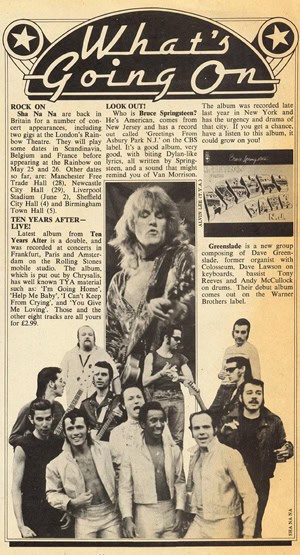

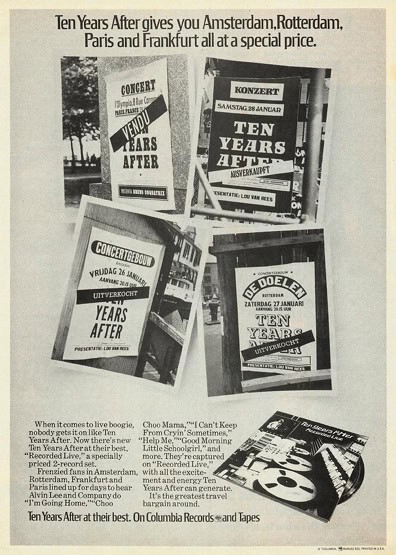
POP Magazine, No. 15 – July 1973
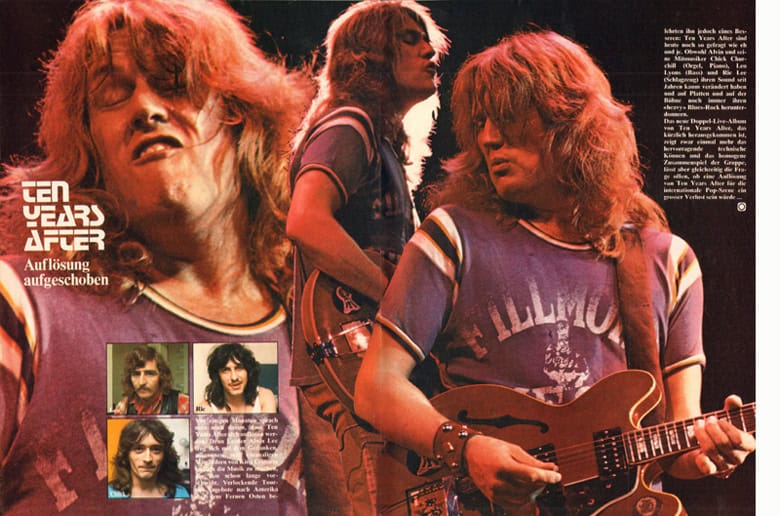
New Musical Express — August 11, 1973
(The concert was August 3, 1973 and took place at Alexandra Palace – North London Venue – called “ALLY – PALLY” for short)
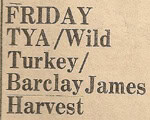
Friday – TYA / Wild Turkey / Barclay James Harvest
I tell ya, the kids still dig Alvin. They started arriving in the late afternoon, and while Wild Turkey and Barclay James Harvest were good, the evening belonged to Alvin Lee and Ten Years After. What better way to spend a Friday night than with a few drinks and bit of boogie. Getting into the festival spirit, kids came prepared with blankets, wine and dope.
“Woodstock Nation” lingers on. The fact that as many people turned out for Ten Years After rock as for Black Sabbath’s satanical music, says something for the youth of today. It warms the heart. Support bands are having an easier time of it as the festival draws to an end. The bigger the act, the larger the crowd and by the time Wild Turkey played, the hall was almost full. I was prepared to quite dislike the band, having seen them in America last year where they impressed me as a very poor fifth rate Jethro Tull imitation. Well, things have changed.
Wild Turkey are by no means just another rock band, and Glen Cornick is simply one of the band; no big ego trips here. While their music leans heavily towards early Tull, Wild Turkey are their own men. The same frantic instrumental burst predominate yet are surrounded by melodic passages. It’s music to listen to, nothing to bash heads against the wall with. All hard driving stuff, occasionally interspersed with a rhythmic acoustic number. The slide guitar songs sound a bit like Wishbone Ash in places, sweet, melodic rock. Tull similarities come to a head on “Traffic Island Jam”, similar to “Cat’s Squirrel” in parts. Everyone takes a solo in this one. Bernie Marsden especially shines on a guitar solo and we all know the merits of Mr. Cornick’s bass playing. The audience gave the band a rousing reception as half the crowd stood screaming for more by the set’s end. They encored with “Butterfly” from their first album. Make no mistake about it, “Wild Turkey” are going to be BIG! Des Henley keeps encouraging all to have a good bop and people seem more than willing to rock out. Fumble are something no festival should be without.
Next up were Barclay James Harvest who offered amazing contrast to the evening’s bill.How their orchestral sounding music got on such a raunchy program is beyond me, yet the crowd willingly listened. A strange lot, those Barclay’s. When they’re good, the music is exciting as it is momentous. Yet on occasion the songs tend to come off as muzak. However, Barclay aren’t as staid as their mellotron cousins, The Moody Blues. Wholly Wolstenholme joked about the bands recent failings in finishing London sets. “We’re a bit nervous about getting through the show”, wolly told the crowd. Barclay James Harvest were the band rained on (or rained off) at White City. A tight unit, the Barclays feed off each other musically. Every so often, someone surprises with an amazing little chunk of sound. John Lee’s moody guitar wanderings highly compliment those sullen mellotron chords. The crowd were quite familiar with the numbers instantly, recognising such Barclay standards as “Mockingbird” and “She Said”. It’s a mystery why the band haven’t yet happened in a bigger way. Their songs are original and often lovely. Maybe the Moodie’s deluge of mellotron based insights ruined the music buying public on bands of the same calibre. Yet the Barclay’s carry on and on, always a welcome addition to any concert bill.
A sense of anticipation growing in the great hall, it was all down to Ten Years After. Filled with thousands of rockers. Alvin had the whole crowd in the palm of his hand. All he had to do was deliver the same goods he’s been displaying for years, and the evening was his.
So as soon as the man announced Ten Years After, the whole of Ally Pally jumped to their feet, letting out incredible shrieks of delight. Surging forward, they madly applauded as the kid walked out on stage. As steady as the rock of Gibraltar, Alvin played his axe.
Ten Years After are a band to enjoy. Who really cares if they do the same things they did years ago. Chuck Berry still plays the same material, and it’s all good fun.
They’ve just got to be the funniest, most enjoyable rock ‘n roll band in the world. Alvin all grimaces and lightning fast licks, Leo Lyons plucking that bass and moving his body faster than the notes he shoots out, Ric Lee the only percussionist with an ever present grin on his face, and Chick Churchill over in the keyboard corner occasionally stepping out and urging all to clap along. And those kids down in front, staring at every move Alvin makes, watching and waiting for every note he plays. They did the old standards. There was Al Kooper’s “I Can’t Keep From Crying Sometimes”, where in the middle of a solo Alvin snuk in a few bars of “Sunshine Of Your Love”. The man’s got a sense of humour. “Good Morning Little Schoolgirl”, announced as a golden oldie, featured the kid on punky vocals. The lad sings a mean tune. Even in the back of the hall where no one could see the stage, the fans loved it.
They loved it cause Ten Years After know how to boogie, and they know how to entertain. That’s why they’re so damn enjoyable, and funny, that Alvin is a gas!
On the serious side, Mr. Lee really is the guitar star we all want him to be. Unfortunately that Woodstock aura still permeates the bands image. Since Woodstock, the world has come to expect only one thing from Ten Years After, and wherever they go, no one will let them off the stage without playing that immortal song.
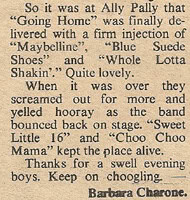
And, so it was at Ally Pally, that “Going Home” was finally delivered with a firm injection of “Maybelline”, “Blue Suede Shoes”, and “Whole Lotta Shakin”. Quite lovely. When it was over they screamed out for more and yelled hooray as the band bounced back on stage, to encore with “Sweet Little Sixteen”, and “Choo-Choo-Mama” kept the pace alive right to the end. Thanks for a swell evening boys. Keep on choogling.
Article written by Barbara Charone
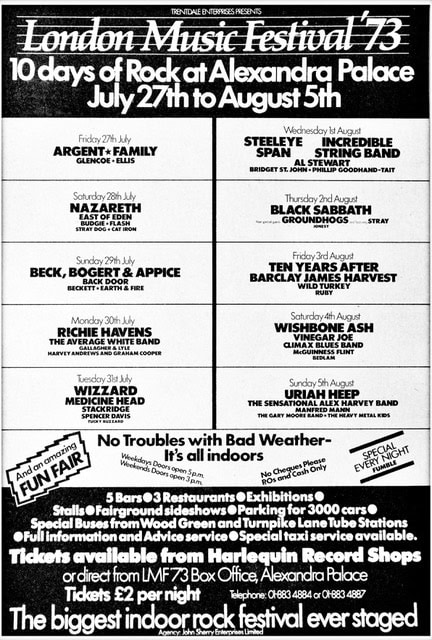
TYA performed Aug 3, 1973
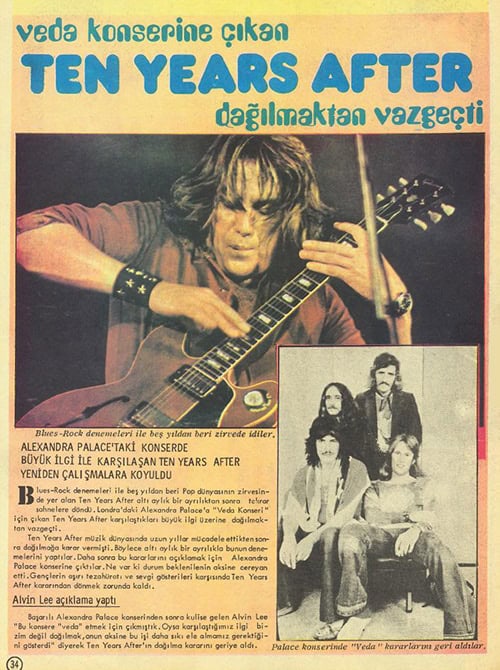
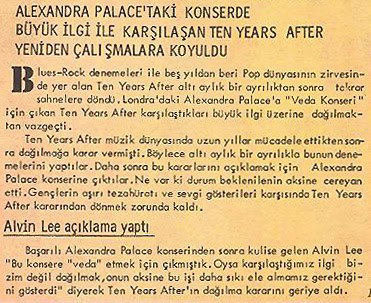
Circus Magazine — August 1973
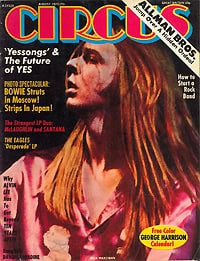
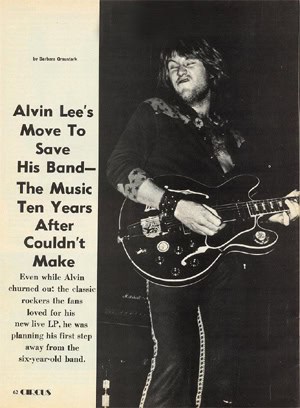
Why Alvin Lee Has To Get Beyond Ten Years After
By Barbara Graustark
Alvin Lee’s Move To Save His Band – The Music Ten Years After Couldn’t Make.
Even while Alvin churned out the classic rockers the fans loved for his new live LP, he was planning his first step away from the six-year-old band. Alvin Lee: Ten Years After still turn him on, but so do the rich, mellow chords and easy country feel of gospel singer Mylon and the jazz-based tunes of ex-King Crimson members, Ian Wallace, Mel Collins, and Boz Burrell. Ten Years After: They claim Ten Years After Recorded Live captures the essence of their choogling music. But after eight LP’s, it’s hard to come up with new material.
Blonde hair flying, bright lips turned downward into the famous strained scowl, Alvin Lee bent further over his slim guitar, hands picking furiously a song he had played at least one thousand times before, “I Can’t Keep From Crying Sometimes”. In the multitude of fans at the Frankfurt, Germany, rock emporium the soulful blues-based rhythms and heartfelt chanting struck a responsive chord. Playing material from every Ten Years After album, from their first, “Ten Years After”, to their last, “Rock and Roll Music To The World”, Alvin, Chick, Ric and Leo kept the crowds open mouthed with fascination as slick fingered Alvin rolled out “I’m Going Home,” then broke into “Scat Thing” with sharply toned vocals that jumped the notes like a frightened deer.
Alvin Steps Out:
But even as a recording mobile unit was capturing what Alvin would later describe as “the essence of Ten Years After’s music” for a new Columbia record album, to be known as “Ten Years After Recorded Live” released in 1973. While rumours were spreading through the British press that the classic oldies which pleased and amazed the crowd were leaving the band less than totally satisfied. And even while the new album was jumping up the charts, Alvin was taking his first major steps away from Ten Years After. His goal? Not to destroy Ten Years After, but to save the floundering band by “broadening my horizons musically”, recording some very different music with some very different musicians.
Making The Social Scene:
The decision to start jamming, Alvin says, crystallized about a year ago, soon after he moved into his five-hundred year old home in Oxfordshire, England. The manor house stood on the edge of the Chilton hills surrounded by forest, and gave Alvin both the privacy and the room to expand his interests. For on the property, he noticed several outbuildings and a big barn which he felt would be the perfect place to build himself a recording studio.
The decision was not a sudden one. For quite some time, Alvin and Ten Years After had found it difficult to come up with new material working under the strained confines and financial pressures of a recording studio, “We need time to experiment,” he revealed.
“At present we’ve always been hampered because you pay $80.00 for every hour you spend in the studio, and that doesn’t give you the relaxed feeling you need for making music. There’s a hope for the band that we’ll be able to get into some new licks,” he explained.
And Alvin himself was more than anxious to “get into a studio and play for twelve hours a day.” But the new music he was envisioning doesn’t stop with Ten Years After. The sixteen track studio will also allow Alvin to record the material he’s been writing and collecting in his three worn spiral notebooks for over a year, the music Ten Years After couldn’t make.
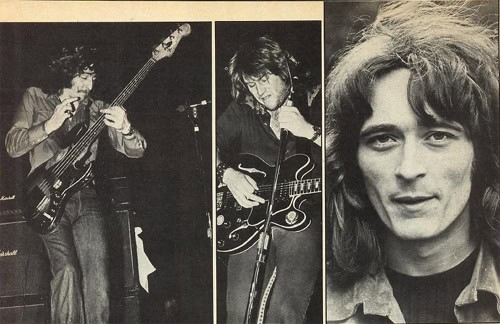
Guitar – Oriented – Tunes:
When Alvin slipped into the studio in June to begin recording his solo album, he carried with him lyrics few of his group’s members had ever heard. “Over the last few years I’ve been writing a lot,” he admitted in his deep midland’s drawl. “A lot that I’ve written hasn’t been suitable for Ten Years After. It’s more influenced by the guitar. Actually, it’s more of an outlet for me personally, rather than the band. I’d like to get into my guitar thing.”
Alvin was determined not to impose his own guitar-oriented style on his band for fear of ruining Ten Years After’s own unique style. “Ten Years After developed quite a strong musical approach, an approach that’s great because it’s free form. But in itself, this is a limitation. It’s loose rock basically. On albums of the past, we have kind of deviated from that style to try other things; but I don’t know, it doesn’t seem right. And I figure Ten Years After should do, what they do best.”
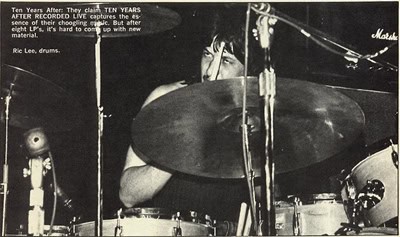
Mellowing Out:
The solo album, on the other hand, will contain overdubbed material, with Alvin playing six different guitars, “which on a Ten Years After album, would be overindulgence. I mean, Ten Years After is a band, and I don’t want to lead it up my own private path.” Carrying his acoustic Gretch guitar and his tape recorder on the road through tours of America, Europe and Japan, Alvin soon collected several volumes of material that presented the lanky guitarist in a far different light from his work with Ten Years After. The sixty-odd tunes fell into varying styles, from “country guitar licks, picking and all,” to sweet lyrical ballads. Much of the material was “too mellow for Ten Years After. I think it’s more mature from my point of view. I’m probably digging around a lot more now. Ten Years After’s stuff is pretty kind of “today I go away,” material. Lyrics that are just words and don’t actually say a lot, they’re sounds. When you rock and roll, you sing sounds, you don’t sing lyrics.”
Words That Mean Something:
Alvin flipped open his notebook to read a few of the poems he wants to convert into songs for the new album. One verse, tentatively titled “There’s No Such Thing As The Top Of The Hill,” barely hides its strong personal meaning:
There’s no such thing as the top of the hill – I’ve never been there again
There’s no such thing as the top of the hill – Unless it’s in your brain
I’ve done what I’m trying to do – I’ve seen what I hope to see
There’s no such thing as the top of the hill – At least there’s not for me.
“I think realization influenced that verse,” he confided. “Everybody has ambitions and when, in reality, you achieve your ambitions and in retrospect you should be on top of the world, you’re not, because there’s so much more to keep doing.”
Struggle For Fulfilment:
Some tunes show Alvin’s persistent struggle for self-fulfilment, the struggle that convinced him to try his hand at the solo venture. Other tunes deal with concrete events, like the feeling of “having your back up against the wall” at the start of an American tour. At times, lyrics dip into mellow pools of despair and alienation. Alvin explained that, “It’s not an idealistic world we live in. When you start thinking in worthy terms, you often get depressed.”
Perhaps his favourite tune, one he’s carried around for years, but never been able to use, sounds his loneliest cry. Entitled “Someday I Hope,” it begins: Informed, transformed from what I was born – but yet I search for truth – While the years chip away at my youth, And I think, when I’m dead! Who will care what I said – So I put down my pen and I go to bed…
Rolling With Mylon:
To ensure that his words are remembered and his music continues to echo in the ears of his fans, Alvin will pull another ace from his sleeve. After the completion of his studio album, he will return to the studio to begin another album, with country-gospel rocker Mylon, who blew Alvin’s mind last year when the Georgian singer first visited the Englishman at his home.
Mylon, Alvin, and Mylon’s guitarist, Steve Sanders journeyed down to the home studio of “The Who’s” Roger Daltrey to lay down several tracks which Alvin later claimed “blew my mind,” and together with producer Allen Toussaint and ex- Mountain bassist and producer Felix Pappalardi hope to continue the work in late summer.
Once Alvin shunned “superstar” jams that forced him to play someone else’s style, or to convince them to play his. Today he has found a group of musicians with whom he can develop a “sympathy” that enables him to blend styles with a newly-fired imagination.
But what of Ten Years After? Alvin seemed determined that the band will continue, even if tours and LP releases are stretched out to allow them all room to grow. “I say we’ll never finish as long as we go on playing good music,” he confirms. “That’s the essence of what we do. There’s no reason to stop making music.”
Giovani Magazine (Italy) — August 23, 1973
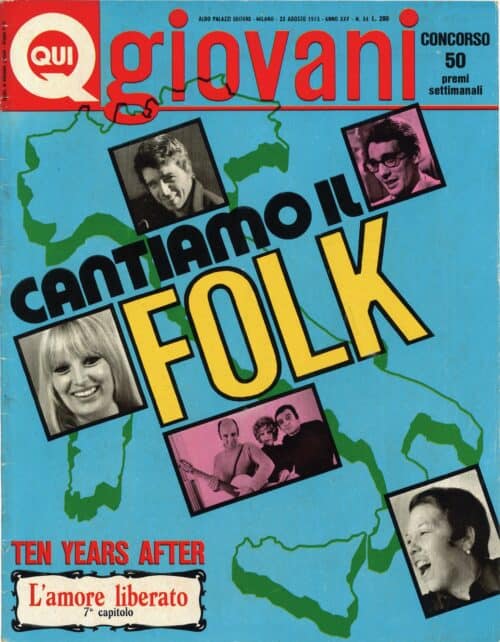
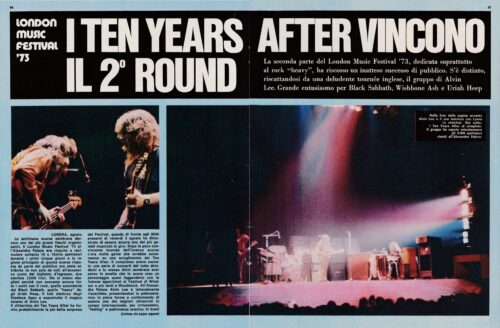
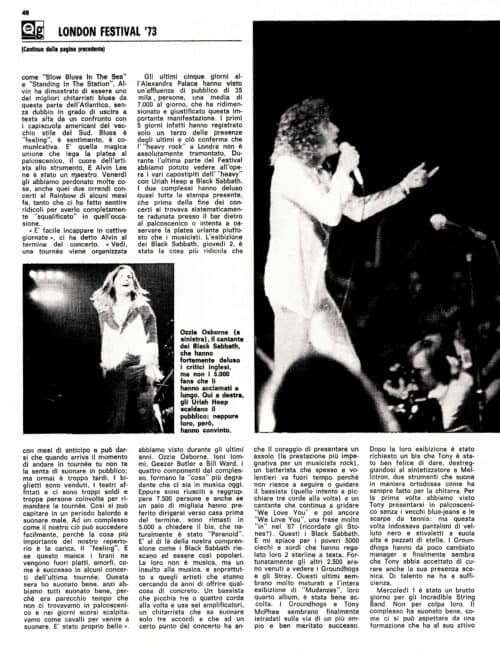
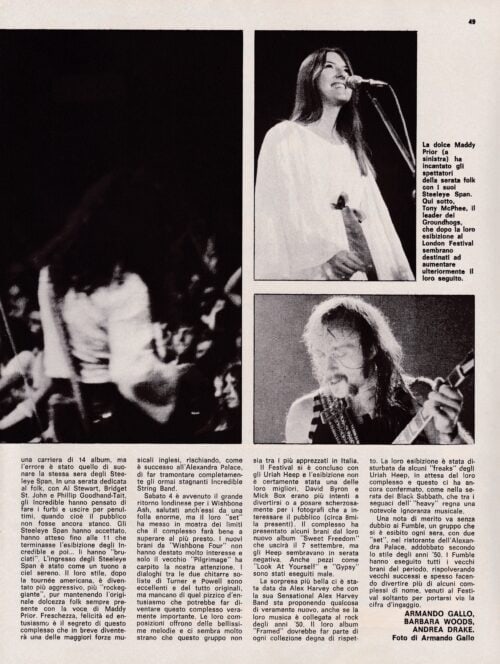
Record Mirror – August 25, 1973
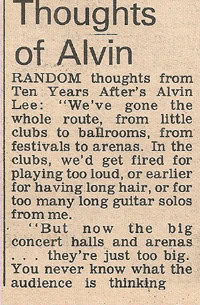
New Musical Express – September 8, 1973
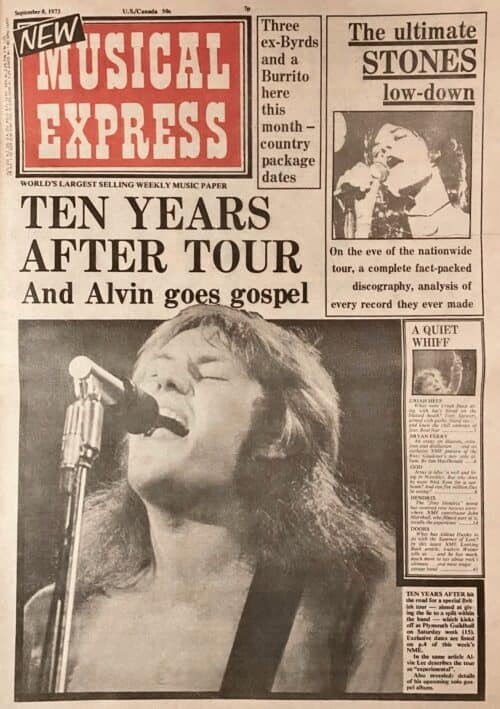
Ten Years After are to make their first British tour in almost a year. The news of the 14 – day tour was announced by Chrysalis this week and effectively puts paid to recent rumours that the group were about to split up. The tour, which opens at Plymouth Guildhall on September 15th, is the first from the group this year, and is their first British appearance since they headlined at the Alexandra Palace Music Festival a month ago. Rumours concerning the break up of the group began circulating at the time of release of “Recorded Live”, the group’s current album. Ten Years After stopped touring at that time as both Alvin Lee and organist Chick Churchill had begun work on solo projects. It was rumoured that Alvin Lee was to leave the group and form a new band with various musicians, namely ex- King Crimson members Mel Collins and Boz Burrell who he had been playing with at the recently-completed studio at Alvin’s home – Space-Studios.
During the past two months, Lee has been working constantly on an album, recorded at his studio with American Gospel singer Mylon LeFevre. The album consist entirely of new songs written by Alvin and Mylon, with additional material from star musicians who also made guest appearances on the album. “I’m looking forward to going on the road with Ten Years After again”, Alvin told New Musical Express. “It’s going to be a tour on which we can experiment, especially during the later part of the tour, when we’ve got back into playing England again. “Since we’ve been off the road during the last few months, I’ve been working with Mylon who’s a gospel singer from Georgia, and we’ve just about finished an album together. It’s not my solo album, it’s the two of us with some good people who came down to help. A solo album is another project I have in mind for the future”. Also at the mixing stage is a solo album from Ten Years After’s organist Chick Churchill. Both the Alvin Lee / Mylon LeFevre album and the Chick Churchill album will be released later this year.

Dates finalized so far for the Ten Years After tour are:
Plymouth Guildhall September 15th, Torquay Town Hall 16th, Swansea Top Rank 17th, Bristol Colston Hall 20th, Hastings Pier Pavilion 22nd, Oxford New Theatre 30th, Manchester Free Trade Hall October 3rd, Leeds University 4th, Newcastle Mayfair 5th, Edinburgh Heriot Watt University 6th, Lancaster University 12th, York University 13th, Wolverhampton Civic Hall 15th, and Glasgow Apollo 19th.
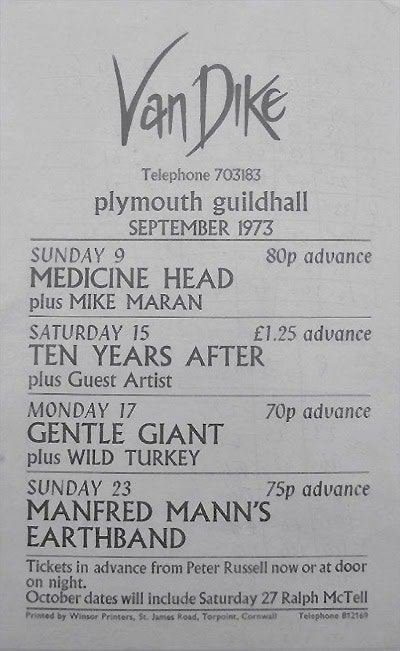
Exclusive Bravo Interview —September 20, 1973
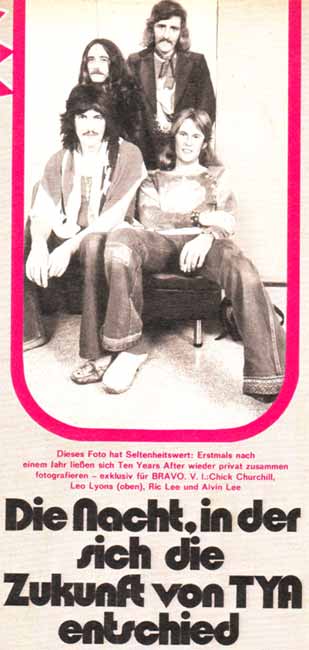
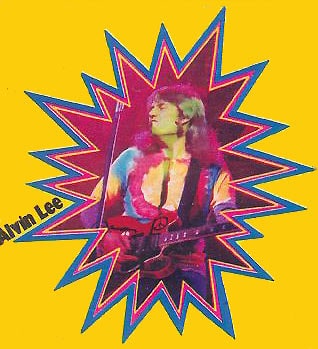
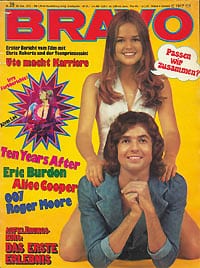

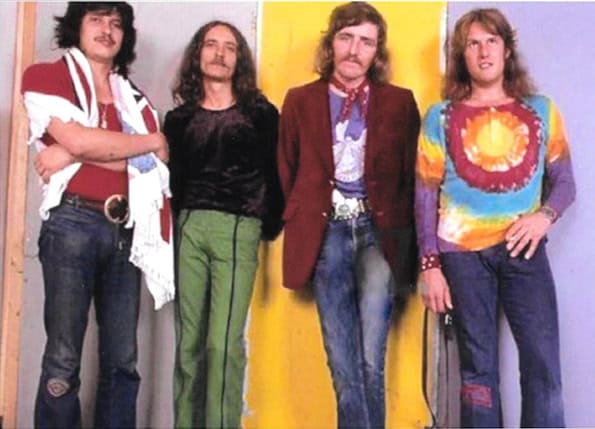
Contribution by John Tsagas
Ten Years After – Hastings Pier, White Rock, Hasting
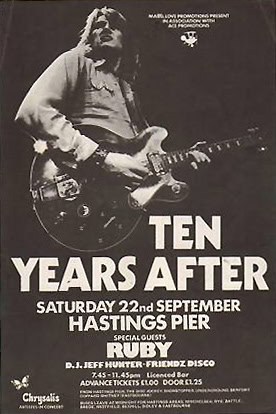
Pier – Pavilions England
On September 22, 1973 played a concert there. The pier was originally opened in 1867, and is still struggling today to remain open today. A temporary walkway has been built over the now unsafe corridor boardwalk floor. Some other bands of note who played there are: “The Who” – “The Rolling Stones” – “The Spencer Davis Group” – “Pink Floyd” – “Hawkwind” – “Status Quo” – “Tom Jones” – “Golden Earring” – “Barclay James Harvest” – “The Can” and of course, “Ten Years After”.
Disaster strikes the famous “Hastings Pier” landmark once again. Known as “The Peerless Pier” when it was first built. On October 5, 2010 ten fire crews were sent to the Victorian Structure in East Sussex, but the fire was to fierce to save anything of the historic building. Two teenagers aged 18 and 19 were placed under arrest on suspicion of arson. The fire burned on for four days. The famous pier first opened on August 5, 1872 and closed in 2006 because of fears that it had become unsafe. Although it had survived the Second World War, The Mods and The Rockers, The Who, The Rolling Stones, Jimi Hendrix and Ten Years After, its 138 year history has now ended for good.
New Musical Express – October 6, 1973
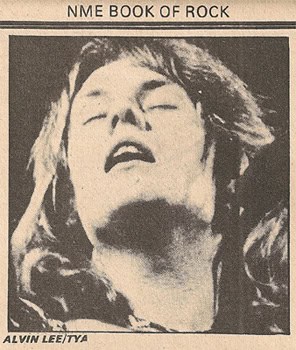
Book of Rock – Page 72 (Revised by Dave)
Alvin Lee – Vocals / Guitar / Harmonica / Songwriter
Leo Lyons – Bass Guitar
Chick Churchill – Keyboards / Organ / Piano / Moog
Ric Lee – Drums / Percussionist
Alvin and Leo met in home-town Nottingham and played together in Hamburg as the “Jaybirds” before being joined by Ric Lee (no relation to Alvin), Chick Churchill was added on keyboards and Ten Years After was now complete. They emerged as one of the top bands of the Second Wave of the British Blues Boom in 1966. Although they relied more heavily on “rock” than on “authentic blues” like their contemporaries, Peter Green’s Fleetwood Mac and Chicken Shack. This ultimately led to a prestigious residency at the Marquee and a spot on the Windsor Blues Festival for Ten Years After, which drew a standing ovation for the group.
By then they had established a style all their own, and that they have stuck close to ever since.
Which is basically blues-based and fronted by the very speedy, and accomplished guitarist Alvin Lee. After their initial success in Britain, they made a big impact on Europe and in the States. With the release of their albums, so too the increase of their fan base, and with the release of the movie Woodstock in 1970, it put them over the top in popularity, fame and money. Both in writing and playing, Alvin Lee came more to the forefront of the band, and right into the title of “Super-Star” and with it superstar status. He also gave the majority of the interviews over the years, to anyone who asked for one it seems.
It was also their performance at Woodstock in 1969 that made their tour-de-force song “I’m going Home” into the groups anthem, and was one of the most exciting musical experiences in the entire film.
After extensive touring, Alvin and the group took some much needed time off between 1971 and 1972 to recover they indicated, from “Woodstock Hangover”. They also wanted to make an attempt at a more than straight rock record. To this end, Ten Years After utilized electronic effects and a much quieter approach to their music. The album went gold and then platinum, with the hit song, “I’d Love To Change The World” in the charts.
The music critics, always at their heals suggested that the band was in a “rut” – but their fans and audiences totally disagreed with that unfounded assessment. Ten Years After still proved to be a strong live attraction, always better doing a live concert, than in the recording studio.
The group got off the road in the summer of 1973 good reasons. Chick Churchill was working on his solo album “You and Me” – Alvin Lee and Mylon LeFevre were working on their album collaboration called – “On The Road To Freedom” and Leo and Ric were working on other personal pet projects.
It should also be known, that Ten Years After have undertaken more tours of the States than any other band in the entire United Kingdom.
New Music Express – October 1973
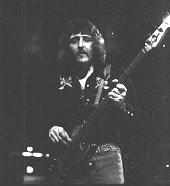
Ten Years After – Alvin Lee, Leo Lyons, Ric Lee, Chick Churchill
Alvin Lee and Leo Lyons met in home-town Nottingham, played together in Hamburg before being joined by Ric Lee (no relation) to form Jaybirds. Chick Churchill added later and name changed to Ten Years After. Emerged as one of top bands of second wave British blues boom (1966) although drawing on “rock”. More heavily than “authentic” contemporaries like Fleetwood Mac, Chicken Shack. Led to Marquee Residency and spot on Windsor Blues Festival which drew standing ovation.
By then had established style that they’ve stuck close to ever since, basically blue-based and fronted by the speedy highly taut and accomplished guitar style of Alvin Lee. After initial success in Britain, made impact in Europe and States with release of Undead and Stonedhenge, The quintessential eary TYA albums. Both in writing and playing, Alvin Lee came more to the fore, being elevated to super-star status after band’s appearance at Woodstock Festival in 1968. Their Goin’ Home tour de-force proved one of most exciting sequences in subsequent movie. After extensive touring, took time off in 71 / 72 to cure “Woodstock Hangover” and to make “A Space In Time” an attempt at more than a straight rock record. TYA utilised electronic effects and a quieter approach. The Album was partially successful.
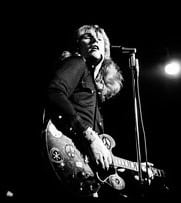
In last few years critics have suggested TYA are in a rut, but band still prove a strong live attraction, Undead (1968) and Recorded Live (1973) give support to the view that they’re often better on stage than in studio. Went off the road for six months through summer ’73, working on solo projects. Alvin Lee has recorded album with Gospel singer Mylon; Chick Churchill also has solo LP upcoming.
TYA have distinction of undertaking more U.S. tours than any other British band.
New Musical Express – October 13, 1973
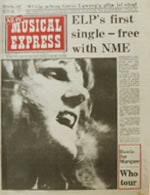
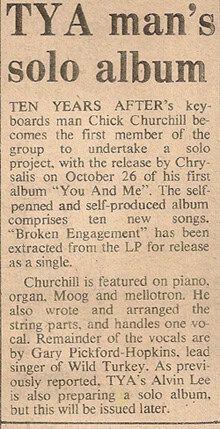
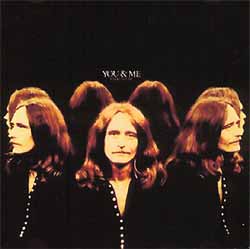
October 19, 1973 — Glasgow Apollo

Ten Years After at the Glasgow Apollo, Scotland’s premier rock venue.
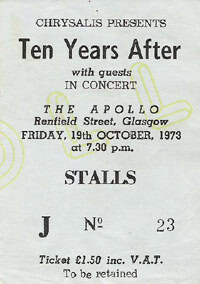

New Musical Express – October 20, 1973
Alvin Lee is quite traditional-minded really.
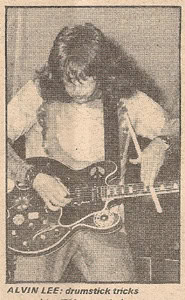
Despite Woodstock, despite a Georgian mansion, he’s still something of a Midlander who sticks to the basic ideas about music he’s worked by all along. In many ways Lee’s philosophy is one of the late sixties. He doesn’t believe theatricals have any place in rock music. He doesn’t feel issuing a single is a valid musical exercise. Maybe it’s his shades of conservatism that have caused Ten Years After to suffer in the last couple of years. Really, there are two ways looking at the band. There’s no doubt they still excel in straight ahead rock for undemanding taste. Yet now perhaps, it’s not unfair to expect something more creative from a band of their stature. Certainly, one feels, in their hearts, even Ten Years After themselves feel their particular style is in danger of becoming redundant. After coming off-stage at the Manchester Free Trade Hall a couple of weeks back, Alvin Lee was comparing the quality of two guitars. One, his normal red Gibson, the other, a different one he used for the show in Manchester. Over in the opposite corner, Leo Lyons rubbed his face with a towel and flashed a self-conscious smile. “So you see, we change our instruments if not our material”. It simply goes to show Ten Years After have been criticised so much for playing the same set that they even make modest jokes about it themselves.
One went up to Manchester to review Ten Years After on their current tour, but found there wasn’t anything new to review. What they played sounded fine, but over-familiar. It was like the band had appeared out of a late sixties time capsule, still preserving with, “Good Morning Little Schoolgirl” and “Going Home”, which Alvin must now be able to play in his sleep. As a guitarist, he pulled out all his gymnastic tricks, including rapping the guitar strings with drum stick provided by Ric Lee drum kit, and there’s Alvin rubbing his guitar strings against the microphone stand.
Still, as the band ostensibly took a five month break over the summer, to work on new ideas with the hope of pulling the band out of a routine that was beginning to sound as tired as an old Hollywood musical. It’s reasonable to ask why nothing had changed. Alvin Lee himself has always defended the old material like “Goin’ Home”, pointing out that it’s what a Ten Years After audience still want to hear. Never the less, drummer Ric Lee helps put the situation in perspective: “I think there’s no doubt that we’ve been in a rut, and that’s one reason why we took some time off. But I don’t think any results will show until after this tour, when we rehearse and put in some new numbers together for the new album. Remember, after Woodstock we did the same thing, and went off the road for awhile, to get out of the standard rock material, that we’d been into. Then we came up with the “A Space In Time” album, which I think was recognized as one of our best.”
One of the more positive results, though, of Ten Years After’s spell off the road has been Alvin Lee’s album with Mylon LeFevre, which is due for release next month and was recorded in Alvin’s home studios. Mylon and Alvin were aided by, among others, Stevie Winwood and for just one track, the song “So Sad”, by George Harrison, a close neighbour of Alvin’s. “Mylon and I just met him at the local Speakeasy,” says Alvin. “Mylon just went up to him and asked him to write a song for the album. He came up with “So Sad” and then came over and played on it as well. In fact, he’s got a great studio himself”, continues Alvin incidentally. “I’ve been over there to play some tapes in the last few weeks, and he’s got it decked out like a living room Victorian studio and with mahogany walls and a teak control desk”. Still despite Alvin’s solo accomplishments, and the future of Ten Years After, still hangs in the balance. Whether they become cast as a stagnant relics of the sixties, now all depends on the results of their next album.
Article by James Johnson
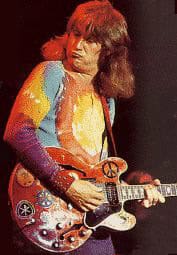
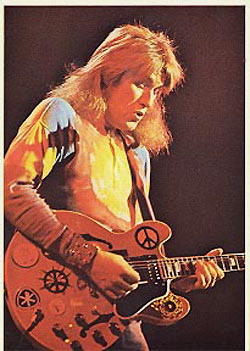
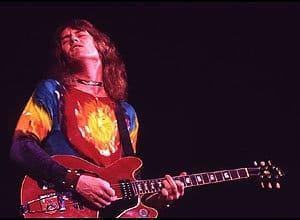
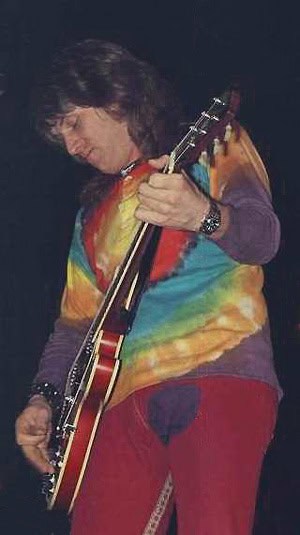
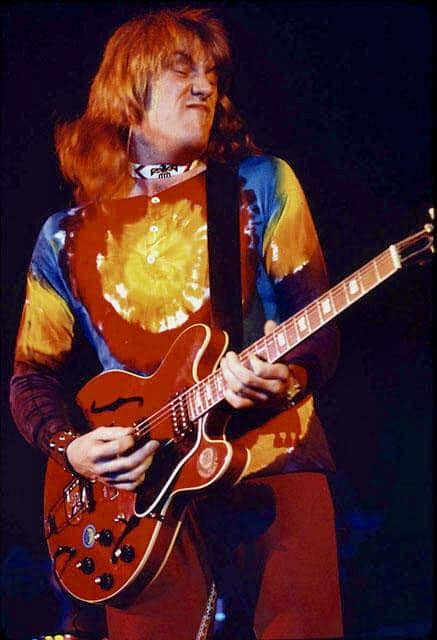

TYA backstage – photos by Pieter Kentrop
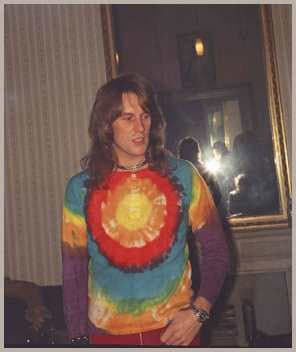
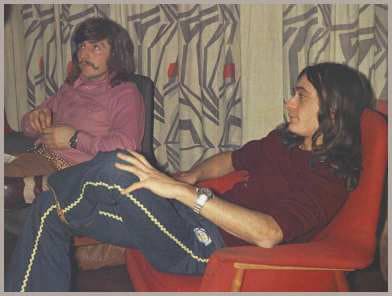
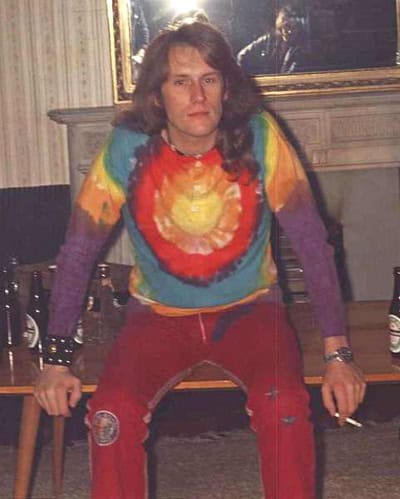
BRAVO Magazine – November 8, 1973
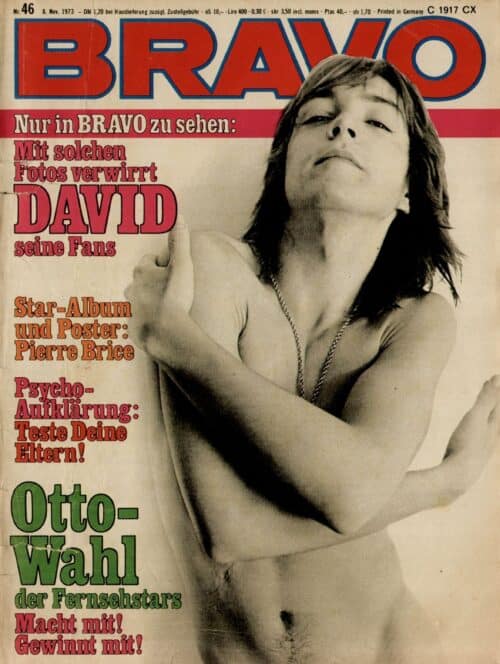

Ciao Magazine (Italy) – November 25, 1973
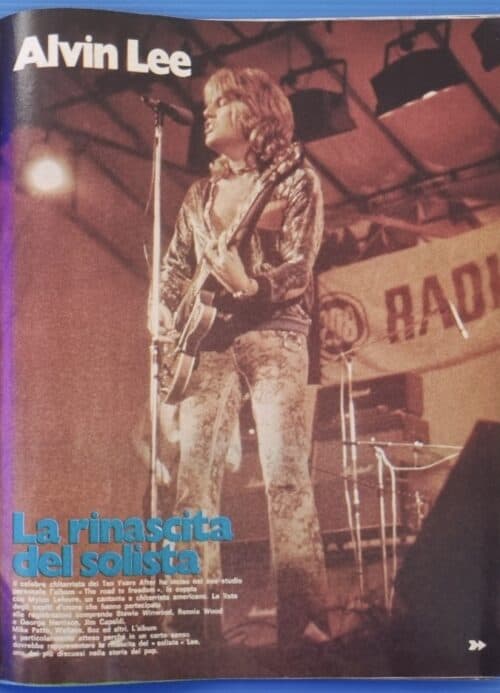
page 53
POP No.25 Magazine (Switzerland, Germany) – December 6, 1973
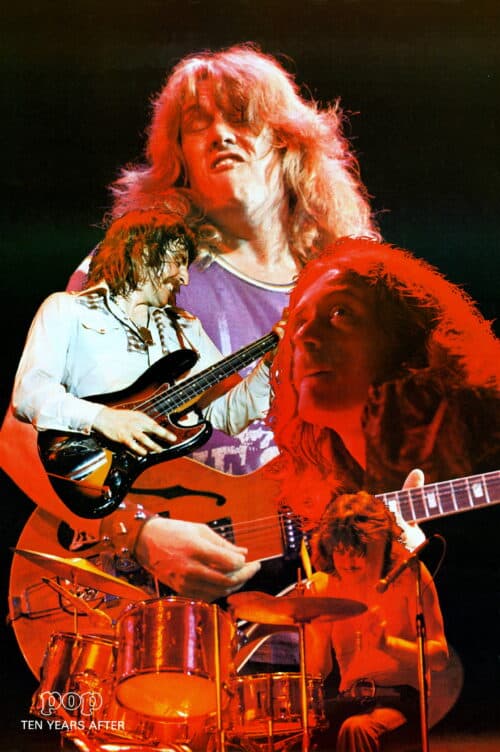
Poster
